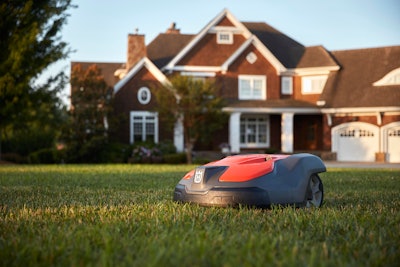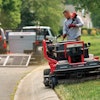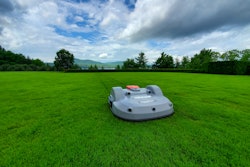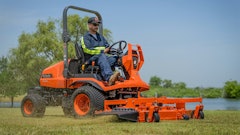
Robotic mowers do a fantastic job of maintaining grass at a specific height of cut and giving commercial and residential sites good curb appeal.
The adoption of such autonomous mowers in Europe has been gargantuan compared to that in the U.S. Robotic mowers technology was part of a discussion during a recent ECHO Means Business Social Media Lounge event.
“If you look at that the worldwide market, the U.S is a little bit slower to adopt this technology than Europe,” says Jake Vollbeer, ECHO Robotics national sales.
In the past few years, consumers and professionals have taken more interest in the use of robotic mowers for a variety of reasons, mainly to offset the cost of labor and looking at the opportunity to have a service that is sustainable or eco-friendly.
“It takes an entrepreneurial spirit from that ground level and it takes a willingness to get into the space and be able to work through some of the growing pains to get the product out into the market,” Vollbeer says.
He suggests that there are a couple of hindrances to adoption in the United States related to the “aesthetic threshold” of the client expectations as to what they want and what they are looking for. “The truth is its growing at a decent pace. As the technology gets better and better, I think you're going to find robotic mowers will be more of the norm,” Vollbeer says. “There's a lot of room for this product in landscaping and in business models moving forward.”
There is little argument within the industry that Husqvarna is an industry leader in terms of robotic mowers and holds most of the market share.
Until recently Husqvarna’s focus has been on the smaller landscapes, although they are making moves to expand more into the commercial realm and larger sites as other manufacturers are doing the same.
Robotics is an area that is ripe for innovation in the green industry. All the manufacturers (ECHO, STIHL, Honda, WORX, Lefthand Robotics and more) are in a race to try to figure out a way to make installations easier and make products work better across all landscapes.
“It's not going to be something that maybe comes out all at once,” Vollbeer says.
In addition to installation, GPS tools and general technological advances, he says compliance with industry standards is another challenge.
“We have to not only create a product that solve the problems that the market demands but it also is going to be compliant with the rules and laws that bind us,” Vollbeer says, adding that for robotic mowing to really take off in the United States there needs to be that product that is just a no-brainer for everyone to purchase.
“We're not to that point yet as a robotics industry, but we will get there,” he says.
For now, manufacturers and dealers continue to pursue the early adopters, those contractors that are willing to take a chance, recognizing the future of the industry and wanting to be a part of it.
Pros
The number one issue facing commercial and residential landscapers is a labor shortage.
From a workforce perspective, robotic mowers are always going to show up for work and do exactly what they are told to do. At the same time, they still need to be managed as either part of the service or as a role of the clients’ responsibility.
“It's easy to forget that because they are autonomous, they're always working,” Vollbeer says. “The truth is you still need to pay attention and monitor it.
“This is a product that is definitely going to require human hands to install, to make work properly, and to maintain and also to communicate with the customers and clients about what it's doing and the benefit it's providing above everything else,” he adds. “Robots are not going to be able to consult and have that that interaction with the customers, which is so important in this industry.”
Robotic mowers do provide landscape contractors an opportunity to reduce or alter their labor force and focus and allow crew members to be put into design and build functions or other areas where there is more significant profit margin. A three-person crew can go down to one person for edging and trimming every two weeks while the remaining two can move into another part of the business.
With those options available, some crews are reluctant when told robotic mowers will start being utilized.
However, Vollbeer, dismisses that thought.
“I guarantee right now robots are not going to replace a vast majority of personnel,” he says. “They are going to allow you to be able to transition your labor into other areas of value for your clients.”
Recognizing that use of the robotic mowers can be a cathartic process for a lot of people in the business it also opens opportunities to do a lot of good for those clients with that extra time.
“It also could make your turn on those areas less expensive because as opposed to spending time going out and mowing four or five clients, depending on the size, now you can hit 15 to 20 just do basic work and cover more clients in a day, while still being able to provide that that service that your company is known for,” Vollbeer says.
In addition, to labor savings, the robotic mowers offer additional savings opportunities.
The mowers are intended to be residents of the area they are servicing.
“It’s not something that you're going to trailer from spot to spot,” Vollbeer says. “Instead of going out with a truck and a trailer and filling up the gas in the morning and going and hitting client spots and performing your mowing duties, and at the same time doing the trim work and all the other things that you provide, now, you just load up a van, or a truck with your electric trimming tools to go out to the site.”
Also, maintenance is reduced in comparison to a regular piece of equipment.
There really is no ongoing maintenance schedule for the robotic mowers. Unlike a standard zero-turn or stand-on unit, contractors are not lubricating or repairing things on a certain schedule. In some cases, the mower will send an error message to indicate the likely problem.
The two parts that need to be replaced and monitored on a regular basis are blades and tires. In addition, technicians can check on the unit and conduct software upgrades periodically.
Vollbeer says most failures with robotic mowers go back to installation. “One of the worst things you can do is try to force a robot into a landscape that it's just not right for,” he says.
Not every site is right for a robotic mower. Being able to look at a site, measure it and make sure that it's the right site for the robot and tell the client no if it’s not a good site, is it going to help you as a professional it's going to help you build credibility, but it's also going to help the robot awareness and adoption rate.
“There are all those types of processes and value-added services that landscapers do for customers are still going to be required but it also allows you to enhance it,” he says. Even the best installations are not going to be able to hit all the intricacies of a landscape and some trim and edging work will be required.
Other concepts in development include having the robots web portal to communicate with the client. “The fact that the customer is going to have to be engaged in it is another opportunity for you, and the landscape community to communicate with your customers and sell more value of your services,” Vollbeer says. “I think that's where there's a lot of benefit in this.”
Also, he says the installation itself is another possible revenue stream as well as the handling and managing of the units.
From a cost perspective, Vollbeer notes that as a landscaper, there is no reason that you can’t lease the robots to customers to help cover the cost.
Most residential contractors using robotic mowers offer it on a subscription-based model or a monthly basis. There is some use of a more direct sales model for corporate clients who want to move the monthly service off their profit and loss reports and move it to a balance sheet on capitalized costs. Under that scenario, the corporation buys the mower outright and has the contractor maintain it under a contract. Generally, landscapers want to own the technology, and then lease it, or use a subscription model to their end customer because that's where they gain the greatest value in the greatest margin.
Cons
One strike against the robotic mowers is the current lack of striping ability. Robotic mowers from most brands cut in a general random pattern while maintaining a quality cut across a property.
“We don't have the ability to put beautiful stripes in the lawn, which is a demand of clients for a lot of people out there that’s a big deal in some areas,” Vollbeer says. In Europe, clients are less concerned with striping.
Mike Bedell, owner of Bedell Property Management in Milford, MI agrees that striping is a bigger deal in certain regions.
“It's definitely a badge of honor amongst the contractor community that our stripes are better than their stripes or my diamond pattern looks gorgeous,” he says.
On the other hand, for many clients, the lawn is just kind of a backdrop to the bigger picture, whether it be flowers or other plants, an ocean view etc. “As contractors we've got to realize that a little bit, that it's cool but is it exactly what the clients paying for?” he says. “If it's not, then you know it might be something that's just kind of a cool fad, and 15, 20 years from now it may be kind of something that's maybe goes back to just being a highlight of a baseball diamond or something like that.”
At some point there will likely be a robotic mower that produces stripes.
“In reality after a few days those stripes are gone anyway,” says Jennifer Lemcke, CEO of Weed Mann and TurfBot. “Honestly, we have seen two Weed Man customers side by side, one with a robotic mower, the other using traditional mowing service and the grass was significantly greener with the robot.”
Also, the environmental concerns, such as removal of clippings is a much greater factor in Europe than in the United States and typically costs more. “It is just another reason it makes it more economically feasible for them to put some of these robotic mowers in the landscape,” Vollbeer says.
It remains unclear whether contractors in North America are ready to embrace the new technology due to the cost. However, the ROI through a subscription-based model can make up for that.
Tracks in the lawn also can be one downside listed by clients. Many of the manufacturers have done well in making sure that the mower doesn't travel the same header around the border of the property anymore. Still, in some parts of the property you could have tracks during certain parts of the season.
There are also issues with the mowers getting stuck in some spots on properties, however, more and more there are tools and resources to help prevent that.
The Future
TurfBot, is one of a handful of companies seeking to franchise the use of robotic mowers.
“Many landscapers are focused on commercial or high end residential (larger lots) and service hundreds of customers so this in itself will not quickly propagate the robotic mowing industry,” Lemcke says, noting that the key to making it a sustainable business is to understand the true costs.
Coming from Weed Man’s base in the residential lawn care segment she says TurfBot is looking at the opportunity to put thousands of mowers in place. Their first year was more about understanding the technology and some of the challenges of servicing a few hundred customers.
“We feel like we have learned a lot and have mastered servicing hundreds of mowers but now we need to scale up to thousands of mowers in the markets we are in,” she says. “Understanding the cost of acquiring a customer is key in understanding the true ROI.”
If you are a small landscape company and are looking to dabble with robotic mowers, it could work, since you have an existing infrastructure and are not looking to create a stand-alone business.
“Our goal is to franchise this concept and we need to make sure that franchisees can make money doing this business as a stand-alone,” she says “We understand the residential customer and understand the importance of not just looking at this opportunity to reduce costs but to truly make money by supporting thousands of customers in any given market.
“Truly this is all so new to many companies, and I feel we have a lot of lessons to learn, but our focus will be to scale up the customer base through franchising,” Lemcke says.
“I think robotics will significantly impact this industry and I see it as the future,” she says. “How can you argue with all the benefits to the environment, noise reduction and the overall health of the turf is impacted? When this takes off, I think customers will demand having their lawn cut with a robotic mower. “
She acknowledges that there is a lot of work to make it more mainstream, but she has seen several larger companies looking into the possibility of use of robotic mowers. “We are so excited to see people wanting to explore this and add it to their portfolio of services, the more the better,” Lemcke says.
Bedell envisions future developments from manufacturers having the robots message clients indicating that it’s time to put down pre-emergent or fall fertilizer, rather than it is coming from the contractor and sounding like an upsell.
“It changes the conversation when their robot lawn mower is telling them that their yard needs to be fertilized and then they call and ask for help with that. I just see all sorts of opportunities with that,” he says. “The robot allows you to focus on areas of the property that aren't the lawn and probably helps you make a little bit more money servicing those clients.
“I think that as time goes on, there's just more and more positives to this and then obviously that gives all the developers more and more time to kind of answer the bell and fine tune their offerings to what's going to fit their best need,” Bedell says.
Just as companies make different sized zero-turn lawn mowers, development of the robotic mowers is happening in a similar fashion.
“This is a conversation that's not going to go away I think that they'll be having this year after year and just getting to talk about all the cool developments and, and probably over time how contractors are using it more and more as kind of a staple of their business,” he says. “I think that as time goes on, there's just more and more positives to it.”
















![Gravely Pro Turn Mach One My23 Dsc03139 Edit 1200x800 5b2df79[1]](https://img.greenindustrypros.com/mindful/acbm/workspaces/default/uploads/2025/10/gravely-pro-turn-mach-one-my23-dsc03139-edit-1200x800-5b2df791.BucBnDoN22.jpg?ar=16%3A9&auto=format%2Ccompress&fit=crop&h=135&q=70&w=240)



